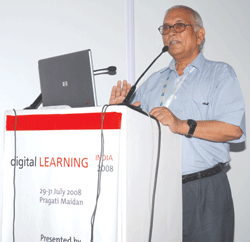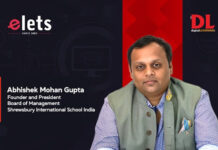 A teacher of Physics and Director, Mira Model School, K K Dhawan has about 45 years of teaching and administrative experience in India and overseas. While teaching in Nigeria in 1978, he came across the first Sinclair computer and knew at that time that technology was going to revolutionise teaching and learning. In the 90s when he joined Mira Model School, he started using computers in his classroom. He also held a workshop where hands on experience of technology to Physics teachers was given, under the aegis of National Progressive Schools Conference in 1993. Subsequently, he established a separate department of Learning Through Computer in the school and also made many modules for teaching science and mathematics. This innovation won the school many awards from Intel, Government of India, British Council, etc. At present Dhawan has tuned his energies into promoting the concept of globalised education, which is a new dimension of technology.
A teacher of Physics and Director, Mira Model School, K K Dhawan has about 45 years of teaching and administrative experience in India and overseas. While teaching in Nigeria in 1978, he came across the first Sinclair computer and knew at that time that technology was going to revolutionise teaching and learning. In the 90s when he joined Mira Model School, he started using computers in his classroom. He also held a workshop where hands on experience of technology to Physics teachers was given, under the aegis of National Progressive Schools Conference in 1993. Subsequently, he established a separate department of Learning Through Computer in the school and also made many modules for teaching science and mathematics. This innovation won the school many awards from Intel, Government of India, British Council, etc. At present Dhawan has tuned his energies into promoting the concept of globalised education, which is a new dimension of technology.
Digital Learning shares with readers Dhawan’s passion for innovation in education.

Please trace the journey of Mira Model School towards ICT integration.
In 1999, in the name of computer education, students would be told about terms like hardware, floppy, CPU, monitor and RAM. I felt that we should go further than than that and so asked the teachers to integrate computers in classrooms to make it more interesting. In 2000 we bagged the national award for the best presentation on integrating technology in curriculum hosted by Intel. This was a major inspiration which thrust our school on the path of ICT. Our school also participated in the competition held by the Ministry of Information and Technology on excellence in computer education in the year 2003 and were the second runners up. In 2005, we introduced the concept of globalised education in our school and in the last two years, we have successfully established regular interactions between our students and those of British schools. We also have Smart Classrooms.
How did you go about implementing HeyMath. What has been the response of the children?
We introduced HeyMath in class 6 as an experiment to see the response of children. With its visual effects, students found it quite interesting. So we held an orientation programme on this for parents of middle school students. Initially only few parents and students came forward, but I am hopeful that more students will come into the fold once sufficient interest is generated. There is also an option of evaluating the performance of children with the help of feedback given by the website. The website monitors how the students are using the software and whether assignments are being done. I thought introducing this would be a small and innovative step towards changing the whole concept of teaching Maths and would also help eliminate boredom among teachers and students.
Do you think that collaboration with foreign institutions is something that is inevitable and good for Indian schools?
Earlier it was difficult to imagine this type of collaboration. But today technology has given birth to a new slogan – ‘kar lo duniya mutthi mein’ (you can hold the world in your palm). Imagine the power technology has given to our children; they can now interact with their peers from around the world and exchange their work.
My school uses a special software Super School++, which has been provided to us by the British Council. In the wide wild world of internet, this software gives children and teachers a safe corridor to interact. Each user has an email and also web pages where they can upload notes on various topics for others to see. All this has been possible because of technology. Technology has brought all of us so near; it has transformed the world into a small village.
What are the major challenges in implementing ICT in schools?
To implement ICT in schools, one needs to be aware of various technology available and how to go about its implementation. We need to address the fear among teachers in accepting technology. While introducing technology, one needs to keep in mind the three T’s – technology, teaching and technique. Content, infrastructure and delivery system are the three basic requirements for introducing technology, but the most important thing is the willingness to do it. The biggest challenge is bringing ICT to schools in rural areas and government schools in urban areas.
The inertia among teachers to use technology aids is another challenge and we need to look at ways of breaking it. I believe that the technology wave is here to stay and we have to accept it for our
own good.

|
Jamia opens Urdu medium school for girls The vice chancellor also announced that 10% seats would be reserved for students belonging to poorer sections of society. ‘The school will hold lessons for classes IX to XII. Class IX will have four sections, three offering education in humanities and one in science stream. There will be around 25 students in each section. In class XI, students will be taught sciences and computers only. The new school will employ 16 new teachers trained in Urdu medium.’ |
|
Mumbai convent schools to bring down class strength ‘With more than 75 students in a class, the quality of teaching is gravely affected. Teachers also complain of not being able to give proper attention to students. At the end of the day, students are the sufferers,’ said Gregory Lobo, Secretary of ABE. Once approved, the new rule will be implemented from the next academic year. The authorities are also working on reducing the school fees. At present, students have to pay Rs.10 per month and in unaided schools, around Rs.350-400 per month. |
|
Green Clubs planned in 250 schools in TN Hailing Tamil Nadu for the successful implementation of the National Green Club (NGC) programme in schools since its inception in 2001, Udayasankar, Deputy Director (Environment Education), Ministry of Environ-ment and Forest, said, ‘As many as 7,500 clubs will be started in 250 schools per district across Tamil Nadu in the current financial year.’ Udayasankar said that in each school around 40 students would be enrolled in the NGC and they would be trained |






















